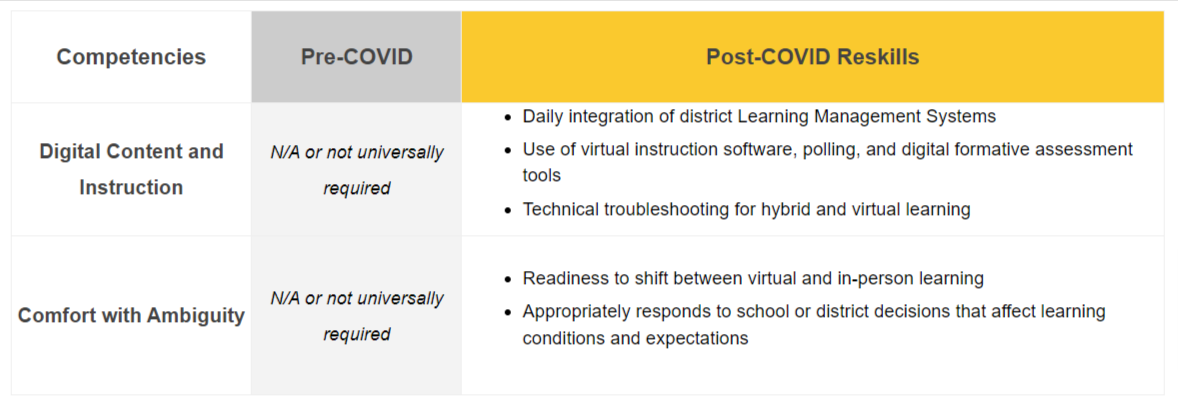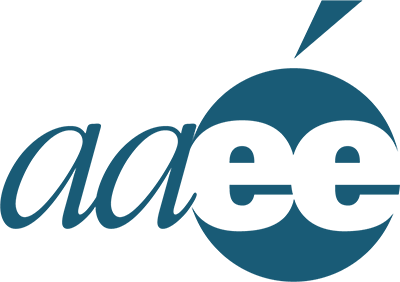Upskilling & Reskilling for the "New Normal" of Education
The abrupt shift to distance learning directly challenged the knowledge, mindsets, and skills of our teacher workforce this Spring. Formerly ‘nice-to-have’ skills in digital integration became ‘must-haves,’ traditional classroom management and instructional design methods no longer applied, and everyone was required to embrace a high level of comfort with ambiguity as guidelines and expectations shifted on a weekly basis. And as a new school year approaches and the global pandemic remains, educators are bracing for these abrupt and temporary changes to make take root.
Regardless of in-person, hybrid, or virtual learning models, teaching and learning will not look the same this Fall. A few knowns:
- Schools must increase virtual readiness (digital platforms, technical skills, virtual expectations and norms)
- Health and safety protocols will affect class sizes, procedures, and instructional strategies
- Students will have experienced learning loss and/or trauma that will affect readiness
- Some students and staff will need to remain at home
Given new conditions, our education system faces the monumental task of preparing teachers for teaching and learning in the year ahead. Our districts are not alone however and can look to organizations inside and outside of education to inform and guide initial steps. Below, we offer three considerations for staffing and development in the wake of COVID-19.
1. Identify Upskills Within Existing Teacher Competencies
The need to update and train our educator workforce existed long ahead of the novel coronavirus. In 2019, the World Economic Forum estimated that the effects of automation, shifts to virtual work, and advances in technology would require more than half of all employees to be upskilled or reskilled by 2022. Work-from-home and social distancing requirements have simply accelerated these needs.
Educators can look to the healthcare industry to see the kind of rapid upskilling that will be needed across our more than three million teachers this Fall. To ensure an ‘all-hands-on-deck’ pandemic response, medical professionals across every area of expertise have received training on the basics of treating infectious diseases, performing common procedures like CPR while wearing PPE, and conducting virtual appointments and diagnoses.
Within education, traditional competencies will require similar forms of upskilling. As a first step, leaders will need to examine these competencies through a pre- and post-COVID lens to identify potential upskills.
For example:

2. Consider Reskilling for New Competencies
Our education system faces unprecedented pressures on staffing in the year ahead. Budget cuts, limits on class sizes, and a significant number of teachers required to stay home (18 percent of teachers are 55 or older) will stretch an already understaffed workforce to new limits. To ease capacity concerns, leaders will need to consider how to reskill both traditional and newly created roles to meet capacity demands.
Educators might again look to the healthcare industry for a model of this kind of reskilling. As hospital capacity stretched thin throughout the initial COVID-19 spike, Scandanavian Airlines designed a three-and-a-half-day training program for cabin attendants to become assistant nurses, both maintaining paychecks for their employees and filling necessary support roles for hospitals. The program has since expanded to laid-off employees from Marriott, McDonald’s, and other companies across the UK.
To alleviate similar stretches on capacity, districts should consider a reskilling of new and existing roles. For example, parents could receive training on leading guided or independent practice with students. Counselors might lead daily small-group instruction on health and wellness to ease classroom sizes. Bus drivers might play a role in delivering WiFi and providing basic in-person technical support for virtual students and teachers. To meet unprecedented demands on capacity and physical space, districts will need to think beyond the traditional teacher role to support new demands on teaching and learning.
Regardless of role and title, a reskilling of new knowledge, mindsets, and skills will need to occur across all positions. Skills and knowledge previously held by virtual instructors, or mindsets for dealing with uncertainty not universally required, will need wholesale training and reinforcement in the year ahead. For example:

3. We Need to Recalibrate Hiring, Development, and Evaluation Efforts
Upskilling and reskilling will require significant human resource efforts across hiring, onboarding, and development structures. By identifying present and future state of skill development, teams can begin to identify both barriers and bridges along new and existing competencies.
Teams might start revisiting hiring profiles to reprioritize knowledge, skills, and mindsets for successful applicants. Previously ‘nice-to-have’ attributes like digital instruction or a high comfort with ambiguity might become must-haves upon hire. Structured interviews will need to be adjusted to include questions and performance tasks that reflect new priorities, for example through virtual lesson demonstrations or questions that probe on how candidates maintain productivity and quality in the face of shifting conditions.
Onboarding and PD structures will also need to reflect upskills and reskills. Summer teacher training programs like Teach For America (TFA) are taking initial steps. In place of in-person teaching and intensive coaching in summer schools across the country, the program is putting additional emphasis on social and emotional learning strategies, training on digital tools for lessons and communication, and rethinking traditional classroom management techniques like the use of proximity. Because the training is virtual, teachers have opportunities to engage in and reflect on effective virtual instruction strategies.
Lastly, districts will need to examine how coaching and evaluation processes align and support revamped expectations. To align managers on training expectations and look-fors, Ford Motor Company recently developed a Return to Work Strategy for its 175,000 plant employees worldwide. Districts will need to consider similar guidelines that include but are not limited to things like virtual instruction practices, CDC compliant seating charts and classroom arrangements, and classroom management and instructional strategies that incorporate social distancing.
Systems Redesign for a Post-COVID World
Businessman and ‘futurist’ Alvin Toffler once said that, “the illiterate of the 21st Century will not be those who cannot read and write, but those who cannot learn, unlearn and relearn.” The abrupt shifts to virtual and socially distant learning are challenging the capacity and traditional competencies of our workforce. As both educators and employers, we have a unique opportunity and responsibility to redefine these skills and develop systems that allow our teachers and support roles to learn, unlearn, and relearn the knowledge, mindsets, and skills necessary to succeed in a new normal.
By Daniel Johnson, Education Elements
Quick Links
Contact
AMERICAN ASSOCIATION FOR EMPLOYMENT IN EDUCATION
2820 S. Alma School Road
Suite 18 PMB 2013
Chandler, AZ 85286






